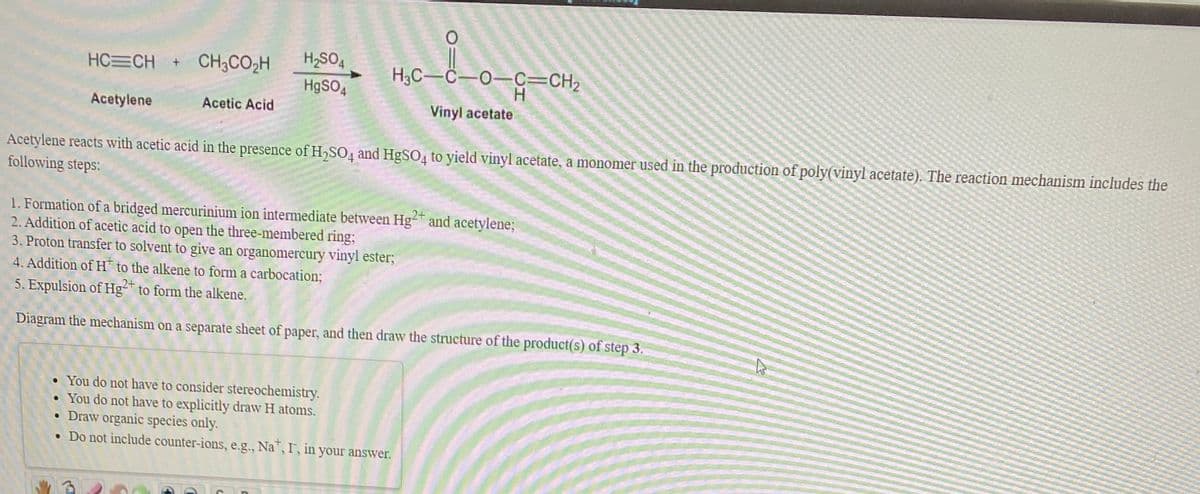HC CH + CH;CO,H H;SO4 HC-C-O-c=CH, HgSo, Acetylene Acetic Acid Vinyl acetate Acetylene reacts with acetic acid in the presence of H,SO, and HgSO, to yield vinyl acetate, a monomer used in the production of poly(vinyl acetate). The reaction mechanism includes the following steps: 1. Formation of a bridged mercurinium ion intermediate between Hg* and acetylene; 2. Addition of acetic acid to open the three-membered ring; 3. Proton transfer to solvent to give an organomercury vinyl ester; 4. Addition of H" to the alkene to form a carbocation; 5. Expulsion of Hg²* to form the alkene. Diagram the mechanism on a separate sheet of paper, and then draw the structure of the product(s) of step 3.
HC CH + CH;CO,H H;SO4 HC-C-O-c=CH, HgSo, Acetylene Acetic Acid Vinyl acetate Acetylene reacts with acetic acid in the presence of H,SO, and HgSO, to yield vinyl acetate, a monomer used in the production of poly(vinyl acetate). The reaction mechanism includes the following steps: 1. Formation of a bridged mercurinium ion intermediate between Hg* and acetylene; 2. Addition of acetic acid to open the three-membered ring; 3. Proton transfer to solvent to give an organomercury vinyl ester; 4. Addition of H" to the alkene to form a carbocation; 5. Expulsion of Hg²* to form the alkene. Diagram the mechanism on a separate sheet of paper, and then draw the structure of the product(s) of step 3.
Chapter27: Biomolecules: Lipids
Section27.SE: Something Extra
Problem 47AP: Cembrene, C20H32, is a diterpenoid hydrocarbon isolated from pine resin. Cembrene has a UV...
Related questions
Question

Transcribed Image Text:HC CH
CH3CO2H
H,SO,
H3C-C-O-C=CH2
H
HgSO,
Acetylene
Acetic Acid
Vinyl acetate
Acetylene reacts with acetic acid in the presence of H,SO4 and HgSO4 to yield vinyl acetate, a monomer used in the production of poly(vinyl acetate). The reaction mechanism includes the
following steps:
1. Formation of a bridged mercurinium ion intermediate between Hg- and acetylene;
2. Addition of acetic acid to open the three-membered ring;
3. Proton transfer to solvent to give an organomercury vinyl ester3;
4. Addition of H to the alkene to form a carbocation;
2+
5. Expulsion of Hg²+
to form the alkene.
Diagram the mechanism on a separate sheet of paper, and then draw the structure of the product(s) of step 3.
• You do not have to consider stereochemistry.
• You do not have to explicitly draw H atoms.
• Draw organic species only.
• Do not include counter-ions, e.g., Na, I, in your answer.
Expert Solution
This question has been solved!
Explore an expertly crafted, step-by-step solution for a thorough understanding of key concepts.
This is a popular solution!
Trending now
This is a popular solution!
Step by step
Solved in 2 steps with 1 images

Knowledge Booster
Learn more about
Need a deep-dive on the concept behind this application? Look no further. Learn more about this topic, chemistry and related others by exploring similar questions and additional content below.Recommended textbooks for you


Organic Chemistry
Chemistry
ISBN:
9781305580350
Author:
William H. Brown, Brent L. Iverson, Eric Anslyn, Christopher S. Foote
Publisher:
Cengage Learning


Organic Chemistry
Chemistry
ISBN:
9781305580350
Author:
William H. Brown, Brent L. Iverson, Eric Anslyn, Christopher S. Foote
Publisher:
Cengage Learning